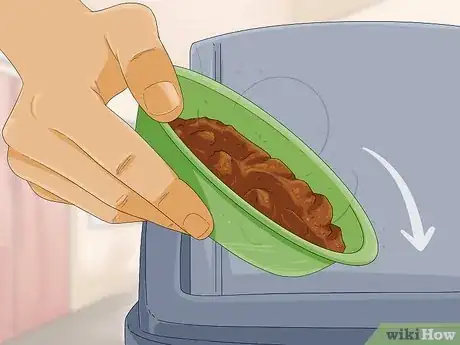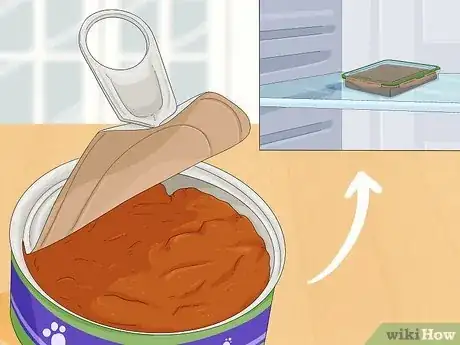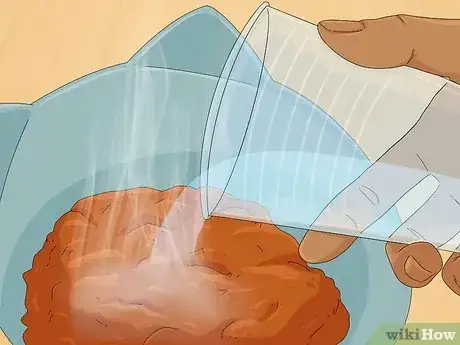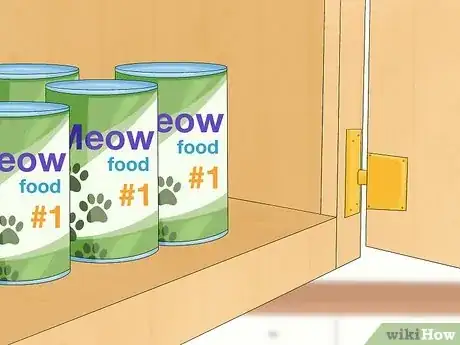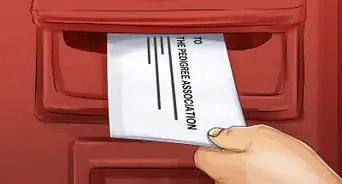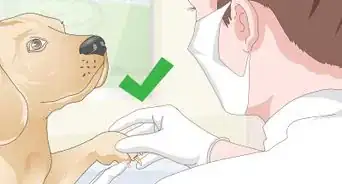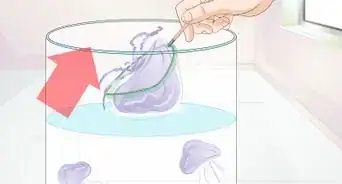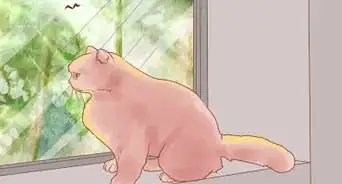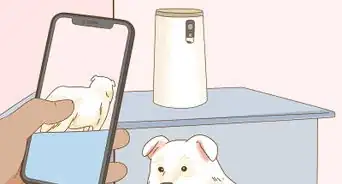This article was co-authored by wikiHow Staff. Our trained team of editors and researchers validate articles for accuracy and comprehensiveness. wikiHow's Content Management Team carefully monitors the work from our editorial staff to ensure that each article is backed by trusted research and meets our high quality standards.
There are 8 references cited in this article, which can be found at the bottom of the page.
wikiHow marks an article as reader-approved once it receives enough positive feedback. In this case, 100% of readers who voted found the article helpful, earning it our reader-approved status.
This article has been viewed 147,567 times.
Learn more...
If you’ve decided wet food is best for your cat, it’s important to keep your chosen brand of cat food safely stored. Food that is out-of-date, improperly stored, or exposed to air for too long can be harmful to your cat’s health. To store wet food properly, keep opened food refrigerated, store unopened food in a cool, dry place, and avoid common storage mistakes to ensure your cat is receiving a healthy meal.
Steps
Refrigerating Opened Wet Food
-
1Put the unused food in an airtight container. If you did not use all of the food in the packaging, put it into an airtight container immediately after opening it. Do not leave the food exposed to room temperature air for any amount of time. A plastic container with an airtight lid or a zip lock plastic bag is okay to use.[1]
-
2Discard opened food after 4 hours. Even if you have food leftover, do not use it once it has been left out. Throw the food away if it has been exposed to the air for 4 or more hours. After 4 hours, there is a chance of bacterial contamination.[2]Advertisement
-
3Store the airtight container in the refrigerator for up to 5 days. Put the airtight container into the refrigerator. Ideally, it should be kept at 40 °F (4 °C) in the refrigerator. Throw out the food if you have not used it within 5 days.
-
4Check to see if the excess food can be frozen. It’s also an option to store unused cat food in the freezer. First, check the packaging to see if there is anything warning against freezing the food. If not, divide the food into single-serve portions. This way, you can thaw individual meals as needed. Although food will last longer in the freezer, it is best to use the excess food within a month.[3]
-
5Keep opened refrigerated cat food for up to 5 days. Some wet cat food comes in cans, but you can also purchase refrigerated cat food. This type of food needs to be refrigerated as soon as you bring it home. If you have this type of cat food, once opened, it can be kept in the refrigerator for up to 5 days.[4]
- If you haven’t opened the food, you can keep it until the expiration date.
-
6Mix chilled food with warm water before serving. Cats typically do not like to eat cold food. Add some warm water to the food. This will heat up the food but not make it too hot for your cat to eat.[5]
-
7Do not mix new and old food. Don’t mix your older, stored cat food with a newly opened container of wet cat food. Although both may be okay for your cat to eat, you may be unknowingly contaminating the new food. Serve the stored food first, and don’t open the new food until you have used or thrown out the stored food.[6]
Storing Unopened Cat Food
-
1Check the best by date of the cat food. If unopened, canned cat food typically can be kept for quite a while. It is always best, however, to check the best by date on the can before giving the food to your cat. Throw out food that has passed its best by date, even if you recently bought it.[7]
- If you just bought a can of cat food with an expired date, you can try to return it for a refund or exchange.
-
2Keep the food in a cool, dry location. Do not store the food in a location that exceeds 100 °F (38 °C) Exposing the cat food to too much heat and humidity can cause degradation in the food. Store the food in a location where it won’t be exposed to sunlight or water. Putting the food in your cupboard or pantry is ideal.[8]
- It is okay to store food in a very cold location. This will not lead to degradation of the food.
-
3Throw away damaged containers of food. Even if you’ve stored the food properly, check the container before storing it. If you see that the packaging has been ripped, it is best to throw the food away. You should also throw out containers of food with visible mold or dampness.[9]
-
4Keep the original packaging. It is best to keep the food in its original packaging until you open it. After opening the food and storing it in an airtight container, do not throw the original packaging away. The packaging contains information you will need if the brand of food is ever recalled.[10]
- Talk to your veterinarian or veterinary nutritionist to ensure you are giving your cat healthy food.[11]
- In general, cats need a high-protein diet. Carefully read the food labels and look up ingredients with which you are not familiar.[12]
- It is better to use a variety of brands and flavors to provide nutrition than relying on one company.[13]
Warnings
- If your cat becomes ill after eating stored food, throw the food away immediately and call a veterinarian.⧼thumbs_response⧽
References
- ↑ https://www.thehonestkitchen.com/blog/6-tips-storing-pet-foods/
- ↑ http://www.petmd.com/blogs/nutritionnuggets/cat/dr-coates/2016/february/how-keep-your-cats-food-fresh-33569
- ↑ http://www.petmd.com/blogs/nutritionnuggets/cat/dr-coates/2016/february/how-keep-your-cats-food-fresh-33569
- ↑ http://www.thedailycat.com/nutrition/keeping_it_fresh/index.html
- ↑ https://thecatsite.com/threads/reheating-wet-food-in-microwave.218580/
- ↑ http://www.petmd.com/cat/centers/nutrition/slideshows/cat-food-storage-mistakes-you-dont-want-to-make
- ↑ http://www.thedailycat.com/nutrition/keeping_it_fresh/index.html
- ↑ http://www.petmd.com/cat/centers/nutrition/slideshows/cat-food-storage-mistakes-you-dont-want-to-make
- ↑ http://www.thedailycat.com/nutrition/keeping_it_fresh/index.html
- ↑ http://www.petmd.com/cat/centers/nutrition/slideshows/cat-food-storage-mistakes-you-dont-want-to-make
- ↑ https://www.vet.cornell.edu/departments-centers-and-institutes/cornell-feline-health-center/health-information/feline-health-topics/feeding-your-cat
- ↑ https://www.vet.cornell.edu/departments-centers-and-institutes/cornell-feline-health-center/health-information/feline-health-topics/feeding-your-cat
- ↑ https://www.vet.cornell.edu/departments-centers-and-institutes/cornell-feline-health-center/health-information/feline-health-topics/feeding-your-cat
- ↑ http://www.thedailycat.com/nutrition/keeping_it_fresh/index.html
About This Article
To store leftover cat food, transfer it into an airtight container and keep it in your refrigerator for up to 5 days. However, if the food has been exposed to the air for 4 hours or more after opening it, throw it away, since there’s a chance of bacterial contamination. Alternatively, check your cat food to see if the leftovers can be frozen. If so, divide the food into single-serve portions and place them in the freezer. Then, use the frozen cat food within a month. For more tips, like how to store unopened cat food, read on!

